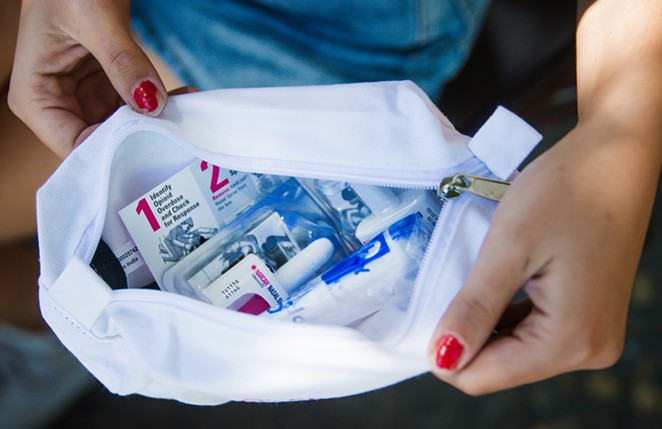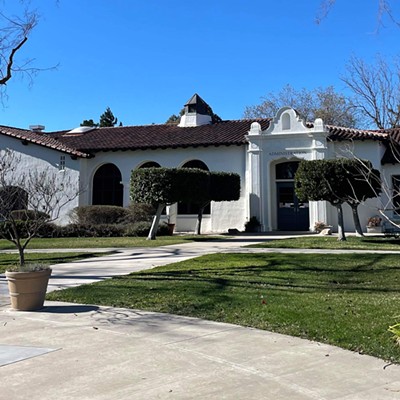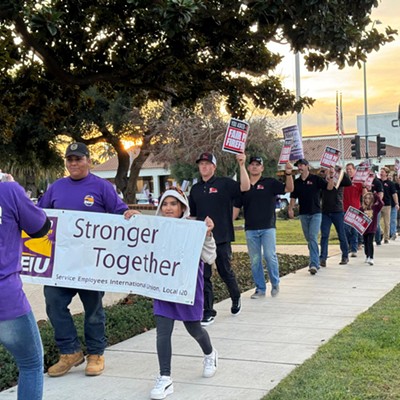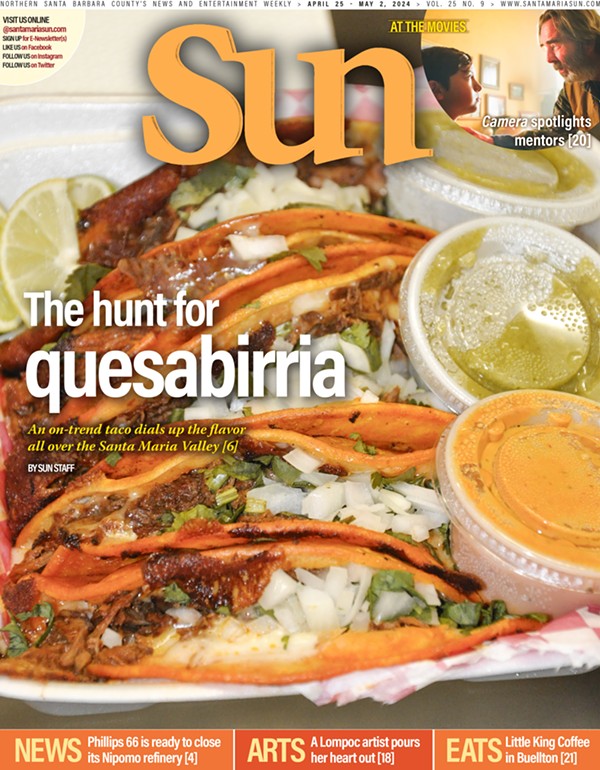A lot more people are going to die from overdoses if harm reduction funding stops, Lois Petty said.
“We’re on the front line; our participants are saving lives, not law enforcement, not the EMTs. Our people are on the front lines and they are the ones who are going to suffer from all of this,” she said.

Petty is one of the founders of SLO Bangers: The only San Luis Obispo County harm reduction organization (and one of three on the Central Coast) that links its participants to public health resources and substance use disorder treatment centers. It also provides sterile syringes, a safe disposal site, access to naloxone—which reverses an overdose’s effects—and gives training in the life-saving medication’s administration, she said.
SLO Bangers’ growth swelled after receiving the 2019 California Harm Reduction Initiative (CHRI) grant—a three-year, $15.2 million grant to support harm reduction programs statewide. It’s the largest single investment in harm reduction ever made in California history, and it funded 37 programs statewide. That grant is now set to expire in December, after the state public health department extended the funding another year.
“We started in November 2007, basically working on pretty much zero budget. I think we had like $10,000 from the county, the county gave us a grant,” Petty recalled. “We were doing one night a week, our Wednesday night—which we’re still doing—and there were only four of us working there.”
With the CHRI funding, Petty and her team got compensated for their work; they added outreach workers, hired participants to provide educational opportunities in their communities, and expanded services countywide—rather than just the city of SLO—and had participants come in from Northern Santa Barbara County, she said.
“Our reach expanded immensely, and we were able to get naloxone out to many more people, which resulted in many lives being saved. We were able to get safe injection supplies, which stops the spread of diseases, and we were able to get out … just the basics: socks, food, sleeping bags,” she said.
According to SLO Bangers 2021-22 fiscal year data, its programs saw more than 1,000 participants, provided 6,264 doses of naloxone, and held 769 individual naloxone training sessions. SLO Bangers participants also reported reversing 680 overdoses.
“We wouldn’t be able to do any of that without this grant, and sadly a lot of that will go away if we’re not funded,” Petty said.
As of April 14, there are no plans to further extend the CHRI grant’s lifespan. While harm reduction policy advocates are working with state legislators to get additional funding in next year’s budget cycle, local organizations are worried about the impacts of drastically reducing their services.
“This grant has saved so many lives, and it doesn’t make sense when our overdoses are increasing; we have new drugs coming down the pipe, and they won’t fund us,” Petty said. “If this money evaporates, a lot of programs are going to fold. They aren’t going to keep their doors open.”
CHRI-funded syringe services programs amounted to a median annual $245,000 budget, about $150,000 more than the median $93,000 annual budget among other syringe services programs in the U.S., according to a study conducted by research nonprofit Research Triangle Institute International. However, these programs were still 46 percent below minimum levels of costs that Centers for Disease Control scientists recommended for small, rural programs.
“Our research found that CHRI was game-changing for SSPs [syringe services programs] in California, greatly improving their ability to deliver life-saving interventions to people who use drugs,” the institute’s research stated.
California Harm Reduction Initiative-supported programs served 7,905 participants in 2021, compared to 3,360 for non-CHRI programs, and connected 85 percent of participants to buprenorphine treatment—a medication that allows people with a substance use disorder to reduce their opioid use without having to visit a specialty clinic on a daily basis, the study added.
Harm reduction programs, like syringe exchanges, are also supported by the Centers for Disease Control (CDC), which states that they are safe and cost-effective, prevent disease, do not increase illegal drug use, and decrease opioid overdose deaths by providing naloxone, according to previous Sun reporting.
Mary Sylla, the National Harm Reduction Coalition’s director of overdose prevention policy and strategy, said that CHRI programs provided naloxone that was responsible for 59 percent of overdoses reversed statewide, when they only received 31 percent of the Narcan, a brand name for naloxone, distributed from the state.
“They are carrying more than their weight to make sure overdoses are reduced. They are the best place to get naloxone in the hands of people who use drugs,” Sylla said. “The best way to make sure overdoses are being reversed is to get Narcan into the hands of people who use drugs.”
The National Harm Reduction Coalition is an organization that advocates for state and national policy reforms that support harm reduction strategies, among many other things, she said.
“At a state level, we have asked for legislator support for four more years of funding for this program,” Sylla said. “We are asking for the state budget to include approximately $61 million for four years, about $15.25 million each year for four years to support this network and expand even more to include additional syringe services programs in places like the deserts—places without syringe services programs.”
State legislators have been receptive to the information the National Harm Reduction Coalition provided, she said, but it’s difficult to get traction for further investment as the state faces a $22 billion budget deficit.
However, she said she’s hopeful as the state is set to receive about $2.05 billion in opioid settlement funds, with 70 percent designated for local jurisdictions.
“From our perspective, state funding is available, and settlement funds need to be used for future remediation of the opioid settlement to make sure that the impact and marketing of opioids as nonaddictive is remediated,” she said.
State Sen. Monique Limón (D-Santa Barbara) told the Sun via email that the California Harm Reduction Initiative is an important program with significant community benefits.
“As with most budget funding, new programs are typically given a preliminary period in order to assess the efficacy of the program,” Limón said. “Even though this specific program may be ending, harm reduction programs are essential and often included in policies that tackle homelessness, wrap-around services, housing, and mental well-being.”
While Santa Barbara County’s Pacific Pride Foundation doesn’t rely on the CHRI grant for its syringe exchange programs, losing any funding stream specific to harm reduction will have severe consequences statewide, Executive Director Kristin Flickinger said.
“We’re fortunate because we provide so many other services that we can allocate staff differently than other organizations that are 100 percent harm reduction services. That is helpful [but] at the same time we are just one organization that doesn’t do just this,” Flickinger said.
Countywide, Pacific Pride provides many organizations with naloxone and training, and Flickinger said she anticipates that need increasing if the grant runs out.
“Having funding that is specifically for syringe services is rare and critical in order to allow on-the-ground organizations to respond nimbly to whatever emerging issues present [themselves],” Flickinger said.
Candace Winstead, SLO Bangers grant manager and program evaluation coordinator, said the organization was denied three major grants, which they applied for in attempts to limit any decrease in services. While it’s fortunate that syringe exchanges are legal in California, and the state public health department allocates funding for supplies to programs, it puts SLO Bangers in a tricky position at the federal level.
“Because we seem like we have it together, it’s really competitive to get national grants. That’s why the CHRI grant is so important because it keeps our programs healthy and able to expand,” Winstead said.
SLO Bangers will not close its doors if the grant doesn’t continue, she said, but it will instead adjust its approach in providing services. It might cause her team to creatively use its volunteers and staff, potentially decrease services, and cut salaries—including Petty’s.
“I could cry talking about it. It’s really competitive and we’re doing the best we can. [We’re] looking for more grants, but there’s no next step in any scenario that involves shutting down,” Winstead said. “This feels really personal to me, and every grant we can apply for we will apply for to the extent that’s possible.”
Contact Staff Writer Taylor O’Connor at [email protected].












